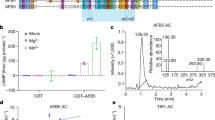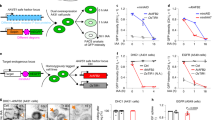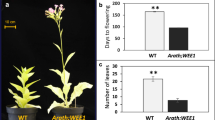Abstract
Cyclic AMP is an important signalling molecule in prokaryotes and eukaryotes1, but its significance in higher plants has been generally doubted2 because they have low adenylyl cyclase activity and barely detectable amounts of cAMP3. Here we used activation T-DNA tagging to create tobacco cell lines that can proliferate in the absence of the phytohormone auxin in the culture media4,5. The sequence tagged in one line, axi 141, was used to isolate a complementary DNA encoding adenylyl cyclase, the first from a higher plant. Sequence analysis reveals that the tobacco adenylyl cyclase is probably soluble, contains characteristic leucine-rich repeats, and bears similarity with adenylyl cyclase from the yeast Schizosaccharomyces pombe. Expression of the cDNA in Escherichia coli results in an increase in endogenous cAMP levels, and in yeast its expression functionally complements the cry1 mutation. Tobacco protoplasts treated with cAMP, or the adenylyl cyclase activator forskolin, no longer require auxin to divide. This finding, together with the observation that the adenylyl cyclase inhibitor dideoxyadenosine inhibits cell proliferation in the presence of auxin, suggests that cAMP is involved in auxin-triggered cell division in higher plants.
This is a preview of subscription content, access via your institution
Access options
Subscribe to this journal
Receive 51 print issues and online access
$199.00 per year
only $3.90 per issue
Buy this article
- Purchase on Springer Link
- Instant access to full article PDF
Prices may be subject to local taxes which are calculated during checkout




Similar content being viewed by others
References
Francis, S. H. & Corbin, J. D. in Signal Transduction (eds Heldin, C.-H. & Purton, M.) 223–240 (Chapman and Hall, London, (1996).
Trewavas, A. & Gilroy, S. Signal transduction in plant cells. Trends Genet. 7, 356–361 (1991).
Assmann, S. Cyclic AMP as a second messenger in higher plants. Plant Physiol. 108, 885–889 (1995).
Hayashi, H., Czaja, I., Lubenow, H., Schell, J. & Walden, R. Activation of a plant gene by T-DNA tagging: auxin-independent growth in vitro. Science 258, 1350–1353 (1992).
Walden, R. et al.Activation tagging: a means of isolating genes implicated as playing a role in plant growth and development. Plant Mol. Biol. 26, 1521–1528 (1994).
Walden, R., Hayashi, H., Lubenow, H., Czaja, I. & Schell, J. Auxin inducibility and developmental expression of axi 1: a gene directing auxin independent growth in tobacco protoplasts. EMBO J. 13, 4729–4736 (1994).
Yamawaki-Kataoka, Y., Tamaoki, T., Choe, H.-R., Tanaka, H. & Kataoka, T. Adenylate cyclases in yeast: A comparison of the genes from Schizosaccharomyces pombe and Saccaromyces cerevisiae. Proc. Natl Acad. Sci. USA 86, 5693–5697 (1989).
Kroll, D. J. et al.Amultifunctional prokaryotic protein expression system: overproduction, affinity purification and selective detection. DNA Cell Biol. 12, 441–453 (1993).
Matsumoto, K., Uno, I. & Ishikawa, T. Identification of the structural gene and nonsense alleles for adenylate cyclase in Saccaromyces cerevisiae. J. Bacteriol. 157, 277–282 (1984).
Kataoka, T., Broek, D. & Wigler, M. DNA sequence and characterisation of the S. cerevisiae gene encoding adenylate cyclase. Cell 43, 493–505 (1985).
Nagata, T. & Takebe, I. Cell wall regeneration and cell division in isolated tobacco mesophyll protoplasts. Planta 92, 301–308 (1993).
Walden, R., Czaja, I., Schmülling, T. & Schell, J. Rol genes alter hormonal requirements for protoplast growth and modify the expression of an auxin responsive promoter. Plant Cell Rep. 12, 551–554 (1993).
Röhrig, H. et al.Convergent pathways for lipochitooligosaccharide and auxin signaling in tobacco cells. Proc. Natl Acad. Sci. USA 93, 13389–13392 (1996).
Holgate, S. T., Lewis, R. A. & Austen, K. F. Role of adenylate cyclase in immunologic release of mediators from rat mast cells: agonist and antagonist effects of purine- and ribose-modified adenosine analogs. Proc. Natl Acad. Sci. USA 77, 6800–6804 (1985).
Seamon, H. B., Padgett, W. & Daly, J. W. Forskolin: unique diterpine activator of adenylate cyclase in membranes and intact cells. Proc. Natl Acad. Sci. USA 78, 3363–3367 (1981).
Taussig, R. & Gilman, A. G. Mammalian membrane bound adenyl cyclases. J. Biol. Chem. 270, 1–4 (1995).
Archdeacon, J., Talty, J., Boesten, B., Danchin, A., & O'Gara, F. Cloning of the second adenylate cyclase gene (cya2) from Rhizobium meliloti F34: sequence similarity to eukaryotic cyclases. FEMS Microbiol. Lett. 128, 177–184 (1995).
Macdonald, H. Auxin perception and signal transduction. Physiol. Planta 100, 423–430 (1997).
Hartzell, H. C., Mery, P.-F., Fishmeister, R. & Szabo, G. Sympathetic regulation of cardiac calcium current is due exclusively to cyclic AMP-dependent phosphorylation. Nature 351, 573–576 (1991).
Lalli, E. & Sassone-Corssi, P. Signal transduction and gene regulation: The nuclear response to cAMP. J. Biol. Chem. 269, 17359–17362 (1994).
Li, W., Luan, S., Schreiber, S. L. & Assmann, S. M. Cyclic AMP stimulates K+ channel activity in mesophyll cells of Vicia faba L. Plant Physiol. 106, 957–961 (1994).
Katagiri, F., Lam, E. & Chua, N.-H. Two tobacco DNA binding proteins with homology to the nuclear factor CREB. Nature 340, 727–730 (1989).
Milner, P. A. & Clausier, B. E. G-protein coupled receptors in plants cells. J. Exp. Bot. 47, 983–992 (1996).
Fritze, K., Czaja, I. & Walden, R. T-DNA tagging of genes influencing polyamine metaboism: isolation of mutant plant lines and rescue of DNA promoting growth in the presence of a polyamine biosynthetic inhibitor. Plant J. 7, 101–111 (1994).
Töpfer, R., Maas, C., Höricke-Grandpierre, C., Schell, J. & Steinbiss, H.-H. Expression vectors for high level gene expression in dicotyledonous and monocotyledonous plants. Methods Enzymol. 217, 66–78 (1993).
Studier, F. W., Rosenberg, A. H., Dunn, J. J. & Dubendorf, J. W. Use of T7 RNA polymerase to direct expression of cloned genes. Methods Enzymol. 185, 60–89 (1990).
Suzuki, N. et al.Leucine rich repeats and carboxyl terminus are required for interaction of yeast adenylate cyclase with RAS proteins. Proc. Natl Acad. Sci. USA 87, 8711–8715 (1990).
Acknowledgements
We thank T. Kataoka for the yeast strain T50-3A and pYEP24-CYRI, W. Schmalenbach for technical assistance, and R. Schmidt for conversations. T.I was supported by a Alexander van Humboldt postdoctoral fellowship. C.S is supported by a DFG studentship.
Author information
Authors and Affiliations
Corresponding author
Additional information
This article was retracted. Some of the results reported in this Letter cannot be reproduced. We know that the data on protoplast division described for Figs 1a, c, 2a, band 4, and the corresponding experimental procedures described in the Methods section and the text, are wrong. In fact, the data showing that cAMP can stimulate protoplast division in the absence of auxins are not correct. Hence, we need to retract this paper. We apologize for any misunderstanding that this might have caused. Note from the Editor: One author, R.W., although concerned with the accuracy of parts of this paper, reserves judgement concerning its retraction and awaits the outcome of further experimentation.
About this article
Cite this article
Ichikawa, T., Suzuki, Y., Czaja, I. et al. RETRACTED ARTICLE: Identification and role of adenylyl cyclase in auxin signalling in higher plants. Nature 390, 698–701 (1997). https://doi.org/10.1038/37810
Received:
Accepted:
Published:
Issue Date:
DOI: https://doi.org/10.1038/37810
This article is cited by
-
Genetic–geographic correlation revealed across a broad European ecotypic sample of perennial ryegrass (Lolium perenne) using array-based SNP genotyping
Theoretical and Applied Genetics (2015)
-
Involvement of secondary messengers and small organic molecules in auxin perception and signaling
Plant Cell Reports (2015)
-
Determination of cAMP in plant cells by a modified enzyme immunoassay method
Plant Cell Reports (2011)
-
Defence transcriptome profiling of Zingiber zerumbet (L.) Smith by mRNA differential display
Journal of Biosciences (2008)
-
Cyclic AMP-dependent phosphorylation of pea proteins induced by forskolin
Russian Journal of Plant Physiology (2005)
Comments
By submitting a comment you agree to abide by our Terms and Community Guidelines. If you find something abusive or that does not comply with our terms or guidelines please flag it as inappropriate.



